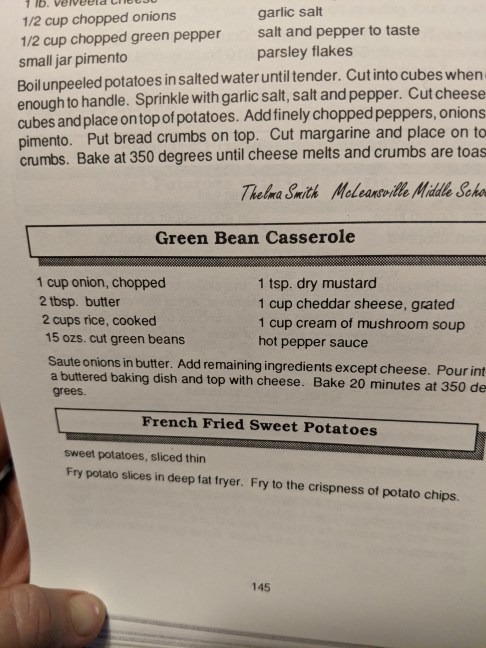The Questionably Straightforward History of Green Bean Casserole
Uncovering the origins of a recipe is typically murky business. It’s usually a hot mix of dire necessity, ingredient availability, and technological innovation, doing a tango with the ego of a chef, or the secretive nature of a housewife guarding her prized recipe.
I actually have a delightful time mucking about in recipe mazes, and was looking forward to what, I assumed, would be The Great Green Bean Casserole maze. But no. Just in time for Thanksgiving 2020, the most disappointing year in a lifetime, the history of GBC just gave itself up.
Here it is:
Thanks to the mid-century industrialization of the American kitchen, I can present to you not only a SINGULAR name of the GBC inventor, BUT an actual YEAR!
In case you’re just here for the cold, hard facts of the case, and none of the commentary because you’re an incredibly busy person, or someone cheating at trivia, here you go.
GBC inventor: Dorcas Reilly
Year: 1955
Why: Dorcas worked for the Campbell’s Home Economics Department, developing recipes for the average American housewife, but using Campbell soup products.
These sorts of departments were common in the early and mid-century, when the field of Home Economics was in it’s genesis (I talk more about that here), then it’s heyday, then subsequently it’s gobbling up by large corporations. (The “test kitchen” is a descendant of these departments, with much less of a gender bias.)
Campbell’s started making their mushroom soup in the 1930s. Dorcas developed a recipe that made use of Campbell’s Cream of Mushroom soup, giving housewives a reason to keep it stocked in their cupboards.
And the rest of the story is told on your Thanksgiving table. The recipe was printed on the back of every can of Cream of Mushroom soup, and Campbell’s estimates that 40% of their mushroom soup sales become Green Bean Casserole. Now that’s a lucrative, and effective, recipe.
This history, and the recipe, is available and celebrated on the Campbell’s website, making it one of the easiest recipes to track down in the whole wide world.
Now, here’s where I question everything. Trivia night is OVER.
Can we truly say Dorcas Reilly invented this recipe?
I have a strong philosophical stance about recipe invention. I don’t believe it’s possible for recipes to exist in a vacuum, hence they never can have a real, singular creation story (doesn’t mean we can’t posture theories, reflect and discuss, however. Please, please do so.)
Was Dorcas the first person to make a casserole containing green beans, which used some sort of roux-based soup to bind it, and had something crunchy on top? I highly doubt it, and so does this suspicious writer from the WSJ.
Also, in this interview with Dorcas later in her life, she admits that it probably was one of her staff who invented the idea in the first place. Could she have carried the guilt of this her whole life?
Her idea is not too dissimilar from a vegetable gratin (a staple of classical French cooking, popular in America at this time), and it follows all the classical points of making a traditional casserole: 1. all ingredients go into a singular casserole dish, 2. it’s baked in a moderate oven for a longish period of time, and 3. served in the same dish it was baked in.
There’s a pretty similar recipe in my 1945 edition of Fannie Farmer’s Boston School Cookbook, major differences being that she calls for cheese with the sauce, and a topping of crushed croutons or corn flakes.
I’m sure if I were to comb through a lot more of my cookbooks predating 1955, I would probably find many more similar looking recipes. However, I don’t think it’s terribly important here, since I already heartily believe that of course there was some kind of predecessor for her recipe.
What I think is fascinating, is how effectively Campbell’s has hung on to the recipe. Recipes cannot be copyrighted, making them free agents to float between people’s homes and stomachs. They don’t need to be loyal, and are not at their best when they are loyal (Edgy stance, I know. *puts on her leather jacket, and rides motorcycle into the sunset.*)
But it does make a company like Campbell’s job tricky, especially in their all-important task of converting a Die-Hard, From-Scratch-Cooking-Only Housewife of the Early 20th century into trusting and using their products.
They had to win the housewife’s trust through consistency of product, firstly. Secondly, they needed to pump out good-tasting recipes that had an undeniable association with their product - and I’m not sure I’ve ever seen a more effective job well done than Campbell’s Cream of Mushroom soup.
They seem to have done it by printing her original recipe for “Green Bean Bake” on the back of every Cream of Mushroom soup can. I imagine they must have also had a pretty aggressive marketing campaign, but I’m having a hard time finding Campbell’s marketing for the dish predating the 90s.
What I would also argue they’ve done, very effectively, is made a BIG point of crediting Dorcas(even though she herself says she probably didn’t come up with the idea). I really can’t think of another big industry American staple in which they give credit to a specific member of their test kitchen. Campbell’s has clung to that history HARD, and I think it really has helped them sell their soup.
Besides, Dorcas looks like such a nice lady - what kind of MONSTER would DARE take her “invention” away from her? In fact, I already kind of feel like a jerk questioning the sincerity of Campbell’s green bean narrative.
To further drive thepoint home, Campbell’s did submit the original recipe to the National Inventor’s Hall of Fame in 2002, solidifying Campbell’s origin story of the recipe.
Though a recipe can’t be copyrighted, it can have a huge hullabaloo made regarding it’s origin story.
The Legacy and Impact of Green Bean Casserole
I personally love GBC, but I also can admit that it’s legacy hasn’t been terribly…classy.
Cream of Mushroom soup is now sometimes referred to as the “Lutheran Binder,” inseparable from it’s role as the glue keeping church potluck casseroles together. You’ll also hear it called “America’s bechamel,” which is exactly it’s function: it’s white sauce in a can.
Scanning through my collection of Midwestern community cookbooks from the 1960s-90s (where I always go-to for the goods), GBC’s impact is noticeable: the cookbooks are chockful of casserole recipes utilizing the cohesive power of Cream o’ Mushroom, or occasionally dipping into the flavors of Cream of Celery, Cream of Chicken, or classic Campbell’s tomato.
From my brief survey of popular American cookbooks written before 1955, I don’t find any recipes using mushroom soup, and fewer casseroles in general. It doesn’t appear the Casserole Renaissance began until after Green Bean Casserole was invented.
I think Campbell’s has done a wildly successful job of keeping their brand the most frequently bought brand for GBC and other casseroles. But what I’d argue is an even bigger deal, however, is their invention truly popularized a new method for throwing food together, and I’d argue that’s a bigger invention than the piping hot dish of green bean casserole that awaits you in just a few short days.
And now, a few pictures from community cookbooks because I love them.

While the Midwestern casserole has fallen out of fashion the past few decades, I predict that within 5 years we’ll see a resurgence of casseroles, starting with a few ironic gestures, and eventually becoming sincere nostalgic indulgences. Casseroles are as versatile as they are convenient - and there’s no reason for them to suck.
Should we be making it from scratch?
I actually got the idea for writing this article while making up a batch of cream of mushroom soup to keep in the freezer for Thanksgiving. I’m perfectly happy to make the soup for the casserole, but I *was* bemoaning that I couldn’t find french fried onions at the store, meaning I’d need to take the time to make my own onion rings on Thanksgiving, when I’d really much rather be sitting around reading the new Harold McGee book about smells.
Which, I mean, heck, green bean casserole with homemade soup and onion rings sounds pretty good, right? And it IS good (I’ve had to do this song and dance before), but it doesn’t taste RIGHT.
At culinary school, quite some time ago, we actually had a Green Bean Casserole Competition over the holidays (which was a very cute idea). We were told to obviously make it all from scratch, no “shortcuts” i.e. “the right way.”
There were a lot of delicious variations on Green Bean Casserole (and a few terrifying ones, because, well, culinary school), but none of them tasted like the real thing.
I was recalling this memory of culinary school as I was stirring my homemade mushroom soup. That’s when I asked the question, “wait, is from scratch ‘the right way’?” Which of course lead me to start googling things, and then lead me to write this article.
Green Bean Casserole has *never* been a from-scratch food. It was invented to be made with shelf-stable (or frozen) ingredients that you can have on-hand at all times. It’s authenticity is it’s convenience, and if you want to “make it right,” you better Can Up.
Happy Thanksgiving, everybody. This year be together in spirit, and on the internet.
